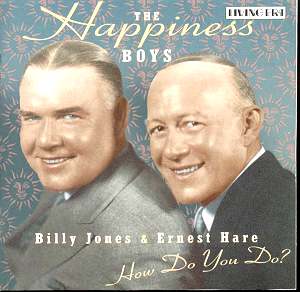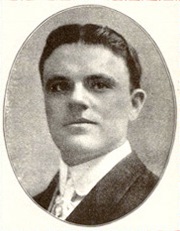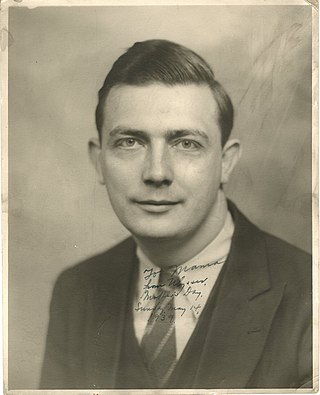
The Happiness Boys was a popular radio program of the early 1920s. It featured the vocal duo of tenor Billy Jones (1889-1940) and bass/baritone Ernie Hare (1883-1939), who sang novelty songs. [1]

The Happiness Boys was a popular radio program of the early 1920s. It featured the vocal duo of tenor Billy Jones (1889-1940) and bass/baritone Ernie Hare (1883-1939), who sang novelty songs. [1]
Jones and Hare were already established as soloists on phonograph records. One of Jones's better solos was "Mary Lou", while Hare scored with the Yuletide novelty "Santa Claus Hides in the Phonograph". In 1920 recording executive Gus Haenschen had them sing an accompaniment on a Brunswick recording. They went on to do numerous recordings for Brunswick Records, Edison, and other companies. Similarities between the two singers were often noted: same height, same weight, birthdays a few days apart. Fred Rabinstein, who worked with Edison, recalled:
Jones and Hare began on radio October 18, 1921 on WJZ (Newark, New Jersey), where they were sponsored by the chain of Happiness Candy stores. Listeners mailed in their comments about the singers on cards supplied to retailers by Happiness Candy. [3]
Beginning August 22, 1923, the Happiness Boys broadcast on New York's WEAF, moving to NBC from a run from 1926 to 1929. The duo sang popular tunes, mostly light fare and comic songs, and they engaged in humorous repartee between numbers. Their theme song was "How Do You Do" (1924). However, only the words to this song were new at that time. The melody had been used for a variety of other songs in the past and is still used in the camp favorite "If You're Happy and You Know It (Clap Your Hands)".

Dave Kaplan was usually the team's pianist on records. Kaplan was in charge of Edison's popular music division (and led the company's house dance bands "Kaplan's Melodists", the anagrammatical "McNalpak's Dance Orchestra", and "Atlantic Dance Orchestra"), but his contract as Edison's bandleader did not restrict his piano accompaniment work on other labels; he was so identified with Jones and Hare that they were jocularly referred to as "The Happiness Boys with Dave Kaplan at the Piano" in a single phrase. The banjoist on the team's records was usually Harry Reser, soon to lead his own band. Fannie Heinline, regarded as the best American female banjoist at the turn of the century, made guest appearances on The Happiness Boys as banjoist and vocalist.
By 1928, Jones and Hare were the highest paid singers in radio, earning $1,250 ($20,000 today) a week. They also made highly successful personal appearances in the United States and Europe. (They mention the European tour fondly in their recording of "We Don't Like It, Not Much".)
Jones and Hare specialized in comic songs that commented on trends and popular culture. When the song "Collegiate" swept the country and prompted a host of similar tunes, Jones and Hare countered with "We Ain't Never Been to College". Gracious living and social propriety were skewered in Jones and Hare's "Etiquette Blues". America's fascination with radio triggered the pungent parody "Twisting the Dials", probably the very first comedy sketch of its kind: Billy and Ernie simulate tuning a radio and getting snatches of random radio programs (Ernie's stentorian recitation of "Gunga Din" interrupted by Billy singing a fast Hawaiian song; Billy saccharinely introducing children's storyteller "Daddy Scarem" [Ernie], who turns out to be pretty grim; an incomprehensible boxing match, etc., punctuated by frequent time-outs for station identifications and time signals).
One of their most pointed satires, recorded with a full orchestra, was "We Can't Sleep in the Movies Anymore". Jones and Hare demonstrate how talking pictures have changed a restful evening in a theater into a noisy onslaught of "sneezes, squawks, and squeals". The lyrics also note that the actors' voices seldom matched their silent screen images:
HARE: The sheik is from the ghetto. I thought he came from Spain.
JONES: His voice is high falsetto! And he sounds like he's in pain!
Jones and Hare kidded the "talkies", but were among the first to appear in the new sound films. They starred in an early Vitaphone short, The Happiness Boys (1927), and were featured in A Movietone Divertissement (MGM, 1928).
Radio's "Happiness Boys" changed their identities and allegiance whenever they changed sponsors. Jones and Hare became "The Flit Soldiers" (1928, for Standard Oil's Flit insecticide), "The Interwoven Pair" (for Interwoven Socks, 1930-33), and "The Taystee Loafers" (for Taystee Bread, 1936), [4] but they were known professionally as the Happiness Boys between these engagements. Toward the end of the 1930s they were sponsored by Sachs Furniture, over New York station WMCA.
When Hare became ill in early 1939, his 15-year-old daughter Marilyn Hare filled in for him at the microphone, allowing the act to continue as "Jones and Hare." Ernie Hare died on March 9, and Marilyn joined WMCA full-time on March 19. [5] She kept singing and joking with Jones for almost a full year. In March 1940 a talent scout for Republic Pictures offered her a movie contract, [6] and she left for Hollywood.
Billy Jones died within the year, on November 23, 1940.
In 1953, a classic vaudeville performance by the Happiness Boys was included in The Ford 50th Anniversary Show , a live television audience of 60 million persons (broadcast live over the NBC and CBS networks). The audio of the Happiness Boys was accompanied by a pantomime performance by Mary Martin and Ethel Merman.
Billy Jones and Ernie Hare's music was recently reissued on the Living Era CD (AJA 5628), How Do You Do?, which brings together two dozen of their more popular hits, including "Barney Google" (lyrics by Billy Rose), "Does the Spearmint Lose Its Flavor on the Bedpost Overnight?" (1924, revived in 1959 by Lonnie Donegan), "I've Never Seen a Straight Banana", "Etiquette Blues", "I Miss My Swiss (My Swiss Miss Misses Me)", "Twisting the Dials", "The Village Blacksmith Owns the Village Now", "Yes! We Have No Bananas" (Billy Jones solo), and "She's the Sweetheart of Six Other Guys" (parody of "Sweetheart of Sigma Chi").

Brunswick Records is an American record label founded in 1916.

William Thomas Murray was one of the most popular singers in the United States in the early 20th century. While he received star billing in Vaudeville, he was best known for his prolific work in the recording studio, making records for almost every record label of the era. Murray was the best-selling recording artist of the first quarter of the 20th century, selling over 300 million records during the phonograph era.

Arthur Francis Collins was an American baritone who was one of the pioneer recording artists, regarded in his day as "King of the Ragtime Singers".

Ada Jane Jones was an English-American popular singer who made her first recordings in 1893 on Edison cylinders. She is among the earliest female singers to be recorded.

Leonard Garfield Spencer was an American singer, composer, booking agent and vaudeville star who was considered one of the most popular recording artists in the United States from the 1890s to the 1910s.

Henry Burr was a Canadian singer, radio performer and producer. He was born Harry Haley McClaskey and used Henry Burr as one of his many pseudonyms, in addition to Irving Gillette, Henry Gillette, Alfred Alexander, Robert Rice, Carl Ely, Harry Barr, Frank Knapp, Al King, and Shamus McClaskey. He produced more than 12,000 recordings, by his own estimate, and some of his most popular recordings included "Just a Baby's Prayer at Twilight", "Till We Meet Again" with Albert Campbell, "Beautiful Ohio", "I Wonder Who's Kissing Her Now" "When I Lost You" and "In The Shade Of The Old Apple Tree". A tenor, he performed as a soloist and in duets, trios and quartets.
"Shave and a Haircut" and the associated response "two bits" is a seven-note musical call-and-response couplet, riff or fanfare popularly used at the end of a musical performance, usually for comedic effect. It is used melodically or rhythmically, for example as a door knocker.
The A&P Gypsies is a musical series broadcast on radio beginning in 1924. With the opening theme of "Two Guitars," the host and band leader was Harry Horlick, who had learned gypsy folk music while traveling with gypsy bands in Istanbul.

Acousticon Hour was a "musicale" radio program aired during 1927 and 1928 on NBC. It offered selections from classical music, orchestral favorites, operas and operettas.

Daniel William Quinn was an American tenor. He was one of the first American singers to become popular in the new medium of recorded music. Quinn was a very successful recording artist whose career spanned from 1892 to 1918. Quinn recorded many of his hits in the legendary Tin Pan Alley of New York City.

William Reese Jones was a tenor who recorded during the 1920s and 1930s, finding fame as a radio star on The Happiness Boys radio program.

Thomas Ernest Hare was an American singer who recorded prolifically during the 1920s and 1930s, finding fame as a radio star on the Happiness Boys radio program.

Frank Ferera was a Hawaii musician who recorded successfully between 1915 and 1930. He was the first star of Hawaiian music and influenced many later artists.

The American Quartet was a four-member vocal group that recorded for various companies in the United States between 1899 and 1925. The membership varied over the years, but the most famous line-up — comprising John Bieling, Billy Murray, Steve Porter (baritone), and William F. Hooley (bass) — recorded for the Victor Talking Machine Company from 1909 to 1913. The same group of singers also recorded for Edison Records as the Premier Quartet, and for that and other labels as the Premier American Quartet. From 1912 to 1914 the quartet also recorded with countertenor Will Oakland as the Heidelberg Quintet.

Frank C. Stanley was a popular American singer, banjoist and recording artist active in the 1890s and the 1900s.
The Green Brothers Novelty Band was a recording ensemble active from 1918 to 1939. The group was led by brothers Joe Green (1892–1939) and George Hamilton Green (1893–1970), xylophone artists along with younger brother Lew Green (1909–1992), on banjo, from Omaha, Nebraska.

Ulysses "Jim" Walsh was an American record collector, columnist and radio broadcaster. He was the leading authority on early recording artists of the late 19th and early 20th centuries, and their techniques, especially through his columns written between the 1920s and 1980s, most notably for Hobbies magazine.

Albert Charles Campbell was an American popular music singer who recorded between the late 1890s and the 1920s. He was best known for his many duo recordings with Henry Burr, and as a member of the Peerless Quartet and other vocal groups, but also recorded successfully as a solo singer both under his own name and under various pseudonyms including Frank Howard.

William F. Hooley was a British-born American bass singer and pioneer recording artist who was popular as a solo singer, as a monologist, and as a member of several of the most successful vocal groups of the early twentieth century, including The Haydn Quartet and The American Quartet.

Harry Anthony was an American tenor and pioneer recording artist. With James F. Harrison he made several recordings of religious music that were popular at the time. He was known as a solo artist, and also became a member of the American Quartet. He made records for most of the major recording companies of the day.